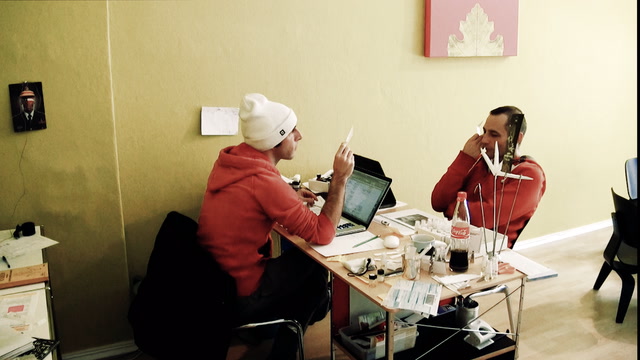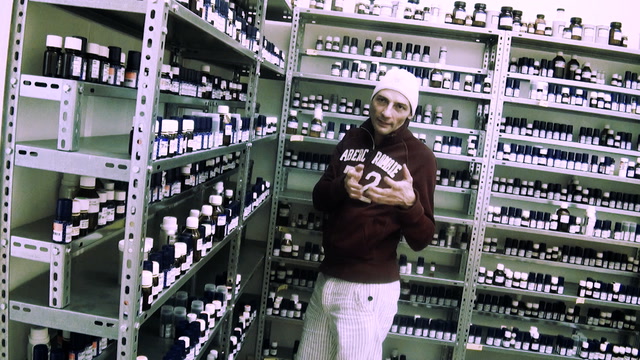Facing A Brainiac2:14

Facing A Brainiac2:14
A good briefing inspires and ignites a perfumer.
The development process for a new perfume involves coordination across various design disciplines: The creative director is not only responsible for the perfume’s name and theme. He is also in charge of preparing the perfume concept (or «brief») and coordinating the overall product fabrication. The photographer shoots the campaign photography. Packaging designers create the bottle, cap and box that will eventually house the perfume when it is finally displayed on the department store shelf. A writer composes press releases and other texts used to market the perfume. Finally, there are the perfumers who develop the fragrance. An additional challenge is that the above designers are often geographically dispersed throughout the world. How is organizing accomplished in such a context that requires coordination among all the designers? How come it does not impede their creative freedom?
In this case the independent designers and their sub-products are coordinated by means of a visual concept which consists of three collages, known as a «mood board.» A mood board is an aesthetic device that connects senses and emotion. It is able to encourage multiple conceptual interpretations while also having a directing and aligning effect. But do the perfumers really care about the concept? For Christophe it is clear that the concept goes beyond the technical brief that dictates raw materials and identifies a target consumer. The concept challenges the perfumer’s creativity. This clip reveals the perfumer’s personal attachment to the concept and its performative qualities: «It is a brainiac».
Evaluative moments2:33

Evaluative moments2:33
Three professionals engage in smelling and discussing an advanced modification of Meltmyheart, a fragrance by StrangeLove NYC.
We see how Christophe Laudamiel, Christoph Hornetz and the flavorist Marlene Staiger spontaneously share their impressions and associations. Apparently, there is no one way of evaluating a scent. A closer look reveals how micro-practices of smelling and using blotters can differ. Christophe is particularly interested how the other two experience a certain effect that he describes as «hot metal effect». The subtitles show how the three professionals cannot agree on what the dominant note of this scent smells like: caramel, coconut and hot metal stand next to each other. A shared interpretation of what they are actually smelling seems to be rather unimportant. Yet, something is achieved in this communication. It is neither explicit agreement nor disagreement. Instead it is the affective experience the three professionals express and collectively interpret as «good». And it is this affective experience that might be key to understanding how organizing is accomplished in a creative context. Is it possible that affects really constitute an organization?
Wet dog: Chasing the villain5:52

Wet dog: Chasing the villain5:52
This clip features a puzzling mystery Christophe encounters when developing a new scent for Strangelove NYC
In most cases, a perfume is meant to be a pleasurable odor. Technically, it is a mixture of essential oils, aroma compounds, and solvents used to provide an agreeable scent. Yet, the process is more complex than often explained. A useful fragrant ingredient might turn out to be an objectionable odor in a specific combination or concentration: Skatole (from the Greek root skato – meaning «dung») for example, is an indole with a strong fecal odor at high concentrations, but it is often used in perfumery at a much lower concentration where it has a pleasing floral scent. Following the development of a jewel-like fragrance we witnessed how Christophe Laudamiel and Christoph Hornetz suddenly discovered an unpleasant facet, an annoying animalic note. Laudamiel calls it a «wet dog» that only appears after some delay. The two perfumers are puzzled. The phenomenon seems to be really special, if also undesired. They investigate the composition, ingredient by ingredient. In the end, the detective search for malodor delivered a suspect for which Christoph Hornetz had noticed the same unexpected effect in other previous instances: Natactone®. The odor of this chemical compound is often described as «tropical coconut, tonka bean and tobacco». Thus, this clip tells the detective story of a puzzling mystery.
A conversation with the material3:53

A conversation with the material3:53
Learning raw materials a perfumery student begins to keep track of associations the smell of these ingredients may trigger.
Short entries in a spreadsheet capture descriptive remarks as well as similarities and comparisons between different materials. In this way a perfumer systematically builds up a network of associations that serve various purposes throughout a professional career. In the case of Christophe Laudamie, we often encountered how he maintained his knowledge base and made note of many new surprises by documenting them in his spread sheet. When searching for possible ingredients Christophe searches through the spreadsheet: «Papery» shows up roughly 30 times. Christophe narrows this down to a shortlist of 5-10 ingredients. He then goes to the lab: «Each bottle contains a whole world - a world by itself», Christophe once remarked. This video shows how Christophe explores the worlds of a few bottles and engages in a conversation with the materials on the shelves.
Key quotes with this tag
Images with this tag

Courtesy of scentculture.tube
A snapshot of Christhope Laudamiel’s knowledge base.

Courtesy of scentculture.tube
The creative potential of scent is used for facilitating workshops in corporate settings. This new field of application is an unexpected outcome of our research.

Courtesy of scentculture.tube
Agnieszka Dabrowska writing a scent inspired story during writing workshop at Solothurn Literary Days, 2019.

Courtesy of scentculture.tube
Sebastian Fischenich, the creative director of Humiecki & Graef, searching for inspiration.

Courtesy of scentculture.tube
A snapshot of Christhope Laudamiel’s knowledge base.

Courtesy of scentculture.tube
Research literature in a data analysis session at Bern University of the Arts.

Courtesy of scentculture.tube
Sharing impressions from smelling the same single molecule ingredient during a workshop.

Courtesy of scentculture.tube
Notes on possible ingredients.

Courtesy of scentculture.tube
Working on a scent brief: making notes. A few moments later the search for papery notes unfolds.

Wellcome Collection, Wellcome Library no. 46973i, CC BY 4.0
The five senses: sight, surrounded by vignettes showing the other senses coloured lithograph by Belin.

Courtesy of scentculture.tube
Christophe Laudamiel revisiting the briefing.

What associations does a perfume awaken…? Bel Epok from Ode #1 Scentual Perception. A publication of Bel Epok, Cologne 2012
All Tags
- Affect
- Ambience
- Ambiguity
- Analogy
- Analyzing
- Artifact
- Beyond words
- Briefing
- Christophe Laudamiel
- Classifying
- Consuming
- Creating
- Culture
- Deciding
- Desk work
- Embodiment
- Ephemeral
- Ethnography
- Evaluating
- Experimenting
- Hemingway
- Humiecki & Graef
- Industry
- Ingredient
- Interaction
- Labelling
- Laboratory
- Metal
- Modifications
- Mundane work
- Orange Flower
- Paper
- Presenting
- Sense-making
- Shalimar
- Smelling
- Storytelling
- Still life
- Strangelove NYC
- Translating
- Visual
- we are all children
- Words

